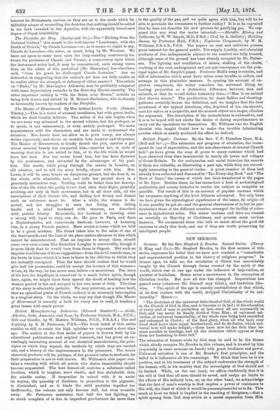British Manufacturing Industries (Edward Stanford) — Acids, Alkalies, Soda, Ammonia,
and Soap, by Professor Church, M.A., F.C.S.; Oils and Candles, by W. Mattieu Williams, F.C.S., F.R.I.S.; Gas and Lighting, by R. H. Patterson, F.S.S.—The fresh batch of this series enables us still to retain the high opinions we expressed a short time ago. The author of the first series of papers is known both by his educational publications and original research, and has given an ex- ceedingly interesting account of our chemical manufactures, the prin- ciples on which they depend, the methods by which they are carried out, and a history of the improvements in the processes. The minor chemical products will be, perhaps, of the greatest value to students, for their preparation is not so well known. Mr. Williams's able paper con- tains a warning with which all artists who desire immortality should become acquainted. The best linseed-oil contains a substance called linokine, which is tougher, more elastic, and less shrinkable than the soluble resins. If turpentine be mixed with it to assist its drying, the quantity of linoleine, in proportion to the pigment, is diminished, and as it binds the solid particles together too inefficiently, the colours not only become dull, but even crumble away. Mr. Patterson maintains that half the bad lighting we so much complain of is duo to imperfect gas-burners far more than to the quality of the gas, and we quite agree with him, but will he be able to persuade the consumers to further outlay? It is to be regretted that he does not describe his new process for purifying gas. We sup- posed this was what the series intended.—Metallic Mining and Collieries, by W. W. Smyth, M.D., F.R.S.; Coal, by A. Galletly; Building Stones, by Professor Hull, F.R.S.; Explosive Compounds, by W. M. Williams, F.R.A.S., F.C.S. The papers on coal and collieries possess great interest for the general public. The supply, locality, and chemical products of this indispensable adjunct to our comfort are fully treated, although some of the ground has been already occupied by Mr. Patter- son. The lighting and ventilation of mines, sinking of the shafts, working of the coal, underground and out-put conveyance are the prin- cipal topics of Mr. Smyth's paper. Professor Hull's essay is concise, and full of information which must have taken some trouble to collect, and arrange in this admirable manner. In opening his account of ex- plosive compounds, the writer considers the universal liking for hurling projectiles as a distinctive difference between men and animals, so that he would define humanity thus,—" Man is an animal that throws stones." The predilection for Aunt Sallies and shooting- galleries certainly favour the definition, and we imagine that the case mentioned of the typical American, who, deprived of his six-shooter, uses his saliva as a projectile, and the nearest object as a target, clinches the argument. The description of the manufacture is exhaustive, and it is to be hoped will not excite the desire of daring experimenters to carry out the operations for themselves. Mr. Williams was the English chemist who taught Orsini how to make the terrible fulminating Fowder which so nearly produced the effect he desired.


































 Previous page
Previous page